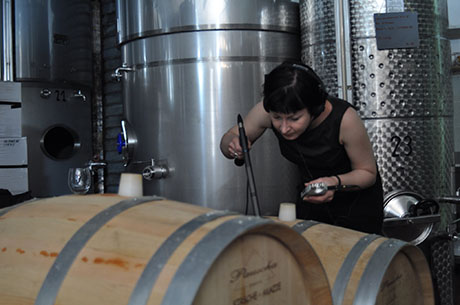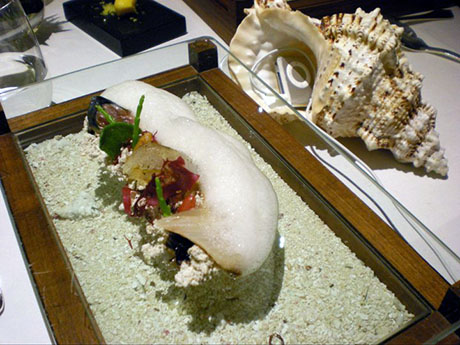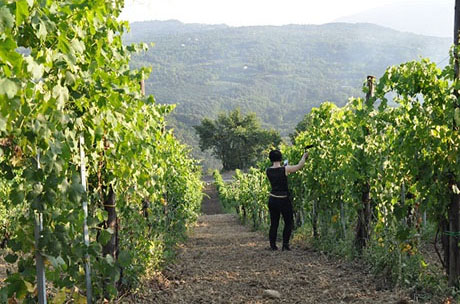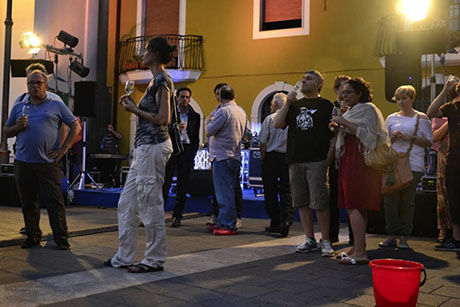
Jo Burzynska, aka Stanier Black-Five, dropping her hydrophone into a wine barrel. Photograph from the Stanier Black-Five website.
Jo Burzynska is a New Zealand-based wine critic who also happens to be an experimental sound artist working under the name Stanier Black-Five (in honour of her favourite-sounding steam locomotive). Her most recent work is a twenty-one-minute multisensory experience that combines both her lines of work.
Titled “Oenosthesia,” a portmanteau built from oeno– and synasthesia, the piece has its origins in a curious observation. As Burzynska explained to Radio New Zealand:
I started noticing that what I was listening to as I was tasting was actually having an impact on my perception of what I was tasting, That led me to do some experiments, which led me to do a series of workshops where I would match music with different wines and show how different sounds and types of music could enhance people’s enjoyment by bringing out the really good characters in a wine—or, conversely, they could do some damage to the wine and make it taste not as good as it should do.
These changes in taste perception are not simply the product of alcohol and wishful thinking: Charles Spence, professor of experimental psychology at Oxford University, has amassed a substantial body of evidence demonstrating “sensation transference,” in which “the brain uses cues from one sense — such as the music we hear—to inform another: taste.”
“We cannot ever eat or drink without being influenced by the environment,” Spence explained to Globe and Mail reporter Ann Hui earlier this year. “Your brain can’t do it. Your brain is always picking up all these other cues and using them to infer what your experience is – how sweet, how tasty, how much do I like it?”

Inspired by Charles Spence’s research, chef Heston Blumenthal’s “Sound of the Sea” dish (oysters, razor clams, and uni served on a “sand” of tapioca and fried panko, then topped with seafood foam) is served with an iPod so that diners can listen to the sound of crashing waves as they eat. Photograph by Naeem Kapadia.
In addition to his IgNobel prize-winning finding that Pringles actually taste crispier when your consumption is accompanied by an amplified recording of in-mouth Pringle crunching, Spence has also demonstrated that higher pitches enhance sweet tastes, while lower tones emphasise bitterness. In The Globe and Mail, Spence speculates that this effect has a biological basis: the tongue naturally curls upward to produce higher-pitched sounds and to draw in sweeter tastes, and downward to make lower tones and to expel bitter food.
Burzynska had noticed a similar effect, finding that higher frequency sounds paired well with both sweet and acidic wines, while lower notes complemented the bitterness of a full-bodied tannic wine.
“Oenosthesia” takes that observation a couple of steps further, resulting in a soundtrack that is not only specially designed to accompany a sequence of wines, but is also made from field-recordings from the vineyards and wineries in which the grapes were originally grown and fermented.

Jo Burzynska, aka Stanier Black-Five, recording in the vineyards near Tufo, Italy. Photograph from the Stanier Black-Five website.
During a week-long residency in the Campania region of Italy in June, Burzynska made extensive field recordings, burying microphones in the soil, hooking them to the wires that the vines are trained on, and even dropping them into vats of fermenting wine. She explained to Radio New Zealand that the process of fermentation can supply an entire acoustic palette by itself:
It was a revelation to me, when I first started recording fermenting barrels of wine, I didn’t realise that different fermentations at different stages sound different. Some winemakers just go and listen to their barrels, and they will be able to tell what stage the fermentation is at.
Based on her own tasting notes, Burzynska then orchestrated the sounds — minimally processed, so as not to distort them — into a composition to accompany, and, at least in theory, enhance three different wines.
The final work has been performed twice — once at the end of the residency, in Italy, and once just a few days ago in New Zealand.

Oenosthesia’s first audience included the local winemakers whose wine and winery sounds were being sampled. Photograph from the Stanier Black-Five website.
The piece begins with the dry, crispy rustling of leaves interspersed with muffled, subterranean gurglings, and a rising chorus of crickets. To accompany this pastoral collage of medium frequencies, Burzynska calls for “a mature Greco di Tufo or similar mid-weight white wine with some richness,” such as Chardonnay.
After six minutes, a series of pops intrudes, gaining speed over the next few minutes to reach a high-pitched, buzzing crescendo that almost sounds like a summer hailstorm on glass, over a backdrop of swirling, rushing liquid. These sounds, of wine-making processes such as agitation and fermentation, will enhance a “youthful Greco di Tufo, spumante/sparkling or comparable minerally high acid white, e.g. Riesling.”
Finally, the piece ends with a lower and deeper sounds, such as the subtle, cyclical drone of the vat cooling systems and the plink-plunk rhythms of the bottling line, and should be accompanied by a full-bodied red, such a Taurasi or a Cabernet Sauvignon.
[soundcloud url=”http://api.soundcloud.com/tracks/56136719″ params=”” width=” 100%” height=”166″ iframe=”true” /]
You can listen to the work in full above; I can attest to the fact that it’s enjoyable even when only paired with a cup of tea, but look forward to improving my next glass of cheap plonk using its synaesthetic qualities. Meanwhile, Burzynska is planning to continue blurring the lines between her two areas of expertise, and has already begun to build an archive of New Zealand winery field recordings. Musical wine labels cannot be far off….
I think I found this via @disquiet, who is worth following either way.

